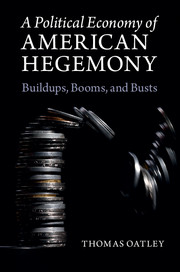Book contents
- Frontmatter
- Contents
- List of Tables and Figures
- Acknowledgments
- 1 The Political Economy of Imbalance
- 2 National Security Shocks and Military Buildups
- 3 Warfare, Welfare, and the Size of the American State
- 4 Military Buildups, Financial Power, and America's Postwar Booms
- 5 Deflecting the Costs of Adjustment
- 6 The Financial Consequences of America's Postwar Booms
- 7 The Political Economy of American Hegemony
- References
- Index
6 - The Financial Consequences of America's Postwar Booms
Published online by Cambridge University Press: 05 February 2015
- Frontmatter
- Contents
- List of Tables and Figures
- Acknowledgments
- 1 The Political Economy of Imbalance
- 2 National Security Shocks and Military Buildups
- 3 Warfare, Welfare, and the Size of the American State
- 4 Military Buildups, Financial Power, and America's Postwar Booms
- 5 Deflecting the Costs of Adjustment
- 6 The Financial Consequences of America's Postwar Booms
- 7 The Political Economy of American Hegemony
- References
- Index
Summary
The tendency to transform doing well into a speculative investment boom is the basic instability in a capitalist economy.
Hyman MinskyPostwar economic booms triggered by military buildups have been the underlying cause of every major episode of financial and monetary instability the United States has experienced since World War II. The United States has suffered two major system-wide banking crises since 1945. The first struck hardest in 1988. Yet, the crisis, which was centered in savings and loan (S&L) institutions, evolved over a longer period. Between 1985 and 1992 approximately half of the existing S&Ls – more than 1,500 in number – were closed due to insolvency. At the time, the S&L crisis was the largest systemic banking crisis to occur in the American economy since the Great Depression. The second systemic banking crisis occurred in 2008. In this episode, five of the largest U.S. investment banks were closed or restructured, commercial banks that collectively held more than 15 percent of all commercial bank assets failed, and the major U.S. banking groups that didn't fail survived only by virtue of a massive injection of public funds. The United States has also suffered one episode of monetary instability. Beginning in early 1968, the United States experienced a run on the dollar, characterized by speculative attacks on the dollar's peg to gold of varying intensity, that persisted through early 1973 and forced the U.S. government to end the convertibility of the dollar into gold and destroyed the international monetary system as a consequence. As is evident, each of these three episodes occurred late in the economic boom, triggered by a major military buildup.
These episodes of financial and monetary instability arose from the booms generated by deficit-financed military buildups. The two banking crises occurred as the last step in a three-stage process. In the first stage, pro-cyclical fiscal policy imparted by the military buildup and the resulting economic boom combined with extremely large capital inflows to spark a credit boom.
- Type
- Chapter
- Information
- A Political Economy of American HegemonyBuildups, Booms, and Busts, pp. 127 - 149Publisher: Cambridge University PressPrint publication year: 2015



